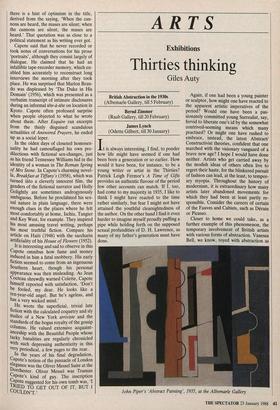ARTS
Exhibitions
Thirties thinking
Giles Auty
British Abstraction in the 1930s (Albemarle Gallery, till 5 February) Bernd Zimmer (Raab Gallery, till 20 February) James Lynch (Odette Gilbert, till 30 January) It is always interesting, I find, to ponder how life might have seemed if one had been born a generation or so earlier. How would it have been, for instance, to be a young writer or artist in the Thirties? Patrick Leigh Fermor's A Time of Gifts provides an authentic flavour of the period few other accounts can match. If I, too, had come to my majority in 1935, I like to think I might have reacted to the time rather similarly, but fear I might not have attained the youthful clearsightedness of the author. On the other hand I find it even harder to imagine myself proudly puffing a pipe while holding forth on the supposed sexual profundities of D. H. Lawrence, as many of my father's generation must have done. Again, if one had been a young painter or sculptor, how might one have reacted to the apparent artistic imperatives of the period? Would one have been a pas- sionately committed young Surrealist, say, fervid to liberate one's id by the somewhat contrived-seeming means which many practised? Or might one have rushed to embrace, instead, the latest Abstract/ Constructivist theories, confident that one marched with the visionary vanguard of a brave new age? I hope I would have done neither. Artists who get carried away by the modish ideas of others often live to regret their haste, for the blinkered pursuit of fashion can lead, at the least, to tempor- ary myopia. Throughout the history of modernism, it is extraordinary how many artists later abandoned movements for which they had been at least partly re- sponsible. Consider the careers of certain of the Fauves and Cubists, such as D6rain or Picasso.
Closer to home we could take, as a further example of this phenomenon, the temporary involvement of British artists with various forms of abstraction. Vanessa Bell, we know, toyed with abstraction as John Piper's 'Abstract Painting', 1935, at the Albemarle Gallery early as 1914 before finding her experi- ments restrictive and unsatisfying. A some- what inept example of such experiment survives in the Tate Gallery's Modern Collection. Painted by anybody else, or at a later time, this painting would be ac- knowledged as unremarkable, if nothing worse.
John Piper, too, experimented with ab- straction. But his Cubist-inspired works, painted around 1935, are distinguished by a spare elegance. This quality is well illustrated in the current exhibition of Thirties abstraction at the Albemarle Gal- lery (18 Albemarle Street, W1). Piper was represented last year in British Art in the 20th Century at the Royal Academy by a single abstract painting, untypical of the later, neo-Romantic idiom through which the artist achieved his acknowledged status in British art. Indeed a good deal of early British abstraction similarly remains of greater historic than aesthetic interest but then it is art historians, of course, who run our museums and organise major survey exhibitions of British art. Luckily the Albemarle Gallery has got together a number of handsome as well as interesting works by artists as various as Jessica Dismorr, Ashley Havinden, Cecil Stephen- son and John Tunnard in addition to those by more obvious figures of the era such as Barbara Hepworth, Henry Moore and Ben Nicholson.
This said, early British abstraction al- ways gives off a slight whiff, for me, of middle-class dilettantism. This odour per- sisted faintly but discernibly in the work of some of the St Ives artists of the Fifties and Sixties. That was a time when those ab- stract artists whose work was rooted in the perceptual were looked on as more back- ward or provincial than their more cerebral or cosmopolitan counterparts. Peter Lan- yon, especially, revelled in the natural elements of his native Cornwall. Yet the untamable majesty of the sea is as much a philosophical as a perceptual concept.
Indeed, it is this precise approach to water which now informs Bernd Zimmer's whirling, expressionistic paintings at Raab Gallery (29 Chapel Street, SW1). As the London arm of a major Berlin gallery, Raab has a policy of bringing some of Germany's better-known younger artists to the attention of the British public. Zim- mer's debt to Emil Nolde's seascapes strikes me as little less massive than some of the works themselves.
James Lynch is a youngish artist whose skills have impressed many at Royal Academy summer exhibitions of recent years. The Duke and Duchess of Devon- shire are among his admirers and so am I, not least because the artist gets on with his work singlemindedly in the depths of the countryside and draws his subject matter unashamedly from rural life. His paintings of farmyard animals are meticulous yet convincing. The woodenness and sen- timentality which afflicted some of the pre-Raphaelites when depicting animals with similar detailed care has been skilfully avoided. Lynch's paintings of cows, pigs, geese and the like tell of real affection for our countryside. See them at Odette Gil- bert (5 Cork Street, W1).
A number of interesting replies to my Christmas competition was received, nam- ing Aylesbury and even Cookham as loca- tions, and painters such as Ben Nicholson, Stanley Spencer and Rex Whistler. The views in question were, however, of Mount's Bay, Newlyn and Lympstone in Devon, the centre one of which I worked on from Harold Harvey's former resi- dence, Maen Cottage, Newlyn, whence that artist painted the subject of the best-selling pre-war print, 'The Blue Door'. The Reverend A. J. Stacpoole identified Mount's Bay correctly in the left-hand study as the subject of a large RA painting by Lamorna Birch. The fine malt whisky donated by Johnnie Walker & Sons will be sent him at St Benet's Hall, Oxford.



























































 Previous page
Previous page